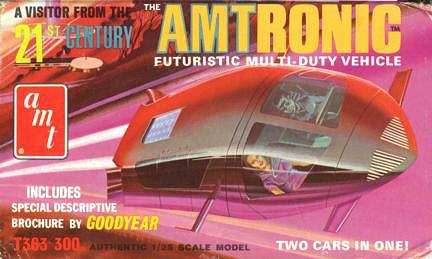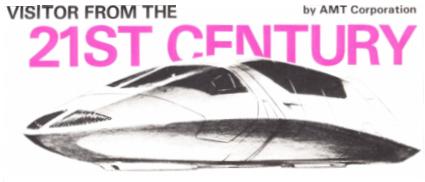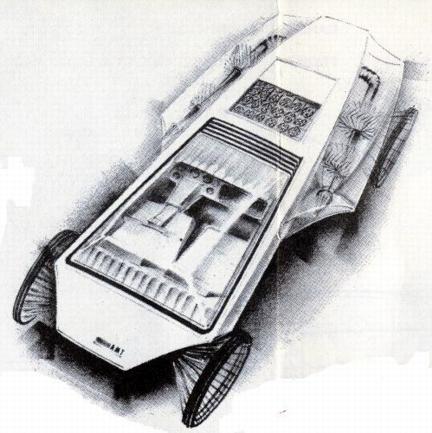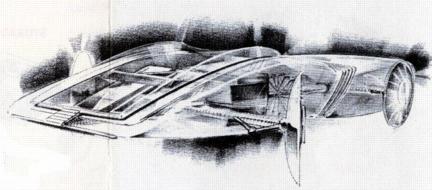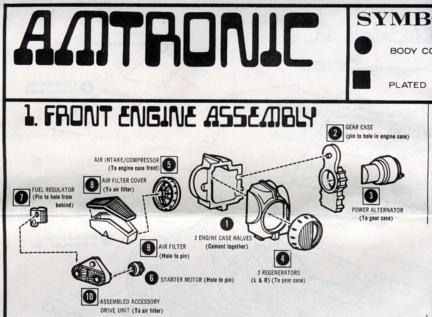AMTronic
Futuristic
Multi-Duty Vehicle
The vehicle is a daring forecast for the family car of the future, a prediction of possible things to come.
A full-size AMTronic would be 21 feet 8 inches long overall and have a width of 7 feet. The front car would be 9 feet 6 inches long and 54 inches high. The entire vehicle would be slightly larger than a Cadillac 75 Limousine. A considerable portion of the car would be occupied by the power units.
The nose section is a complete two-passenger unit powered by a turbine-driven alternator which powers two electric motors, one in each of the drive wheels. The rear cabin is an add-on four-passenger compartment which also contains the main power supply which drives the complete unit traveling from city to city.
Tires for the AMTronic were designed by the Goodyear Tire and Rubber Company expressly for the AMTronic, and are of a revolutionary cross-section and ultra-low profile design. Machined alloy die cast wheels would be used for high strength and light weight.
The body is of monocoque aircraft construction utilizing lightweight alloys and plastics.
When the unit is used as a town car, steering is accomplished by retractable nose wheels which drop down, in aircraft fashion, from the front of the car. When the fore and aft units are joined, the vehicle is driven to the express-chutes powered by both the front car drive wheels and the rear cabin wheels. Steering is then accomplished by both the nose wheels and the front car drive wheels which automatically syncrolock with the nose wheels when the two units are joined.
The transition from a wheeled vehicle to an airborne unit is accomplished when the vehicle enters the express chutes. Lateral control arms, one on each side of the vehicle, extend to make electromagnetic contact With the guard rails on each side of the chute. This automatically actuates the computer control system which takes over control from the vehicle's operator.
As the vehicle gains speed, the ducted fans are engaged, supporting the AMTronic as the wheels retract. Propulsion up to this point has been accomplished by the drive wheels, assisted by the exhaust from the turbojets. The two turbojets now take over, boosting the vehicle to its cruise speed.
As the unit attains cruising speed, it is fed onto the main chute from the entrance chute and electronically synchronized with the vehicles already traveling down the inter-city and inter-state express chutes. At the point, the vehicle is essentially a Hovercraft, driven by the twin turbojets at a cruising speed of approximately 300 MPH.
The guide plates on the vehicle act as position sensors and signal any change required to control pitch and yaw. Traffic information is also fed into the vehicle though the guide plate controlling the speed and braking.
The on-board computer system controls all functions of the vehicle, including environment and entertainment. The computer system functioning in both front and rear unit, would incorporate integrated circuits enabling the use of rather sophisticated hardware in a small space.
For extended trips, the operator would insert a rep-programmed trip card which the computer would analyze along with the current and changing traffic and weather conditions and then offer a choice of several routes. With the choice made, the AMTronic would automatically follow the selected route, making necessary corrections only if emergencies arose. Should the side guide rails lose power, or if the engines default, the computer would take over complete control and execute the best of alternative plans for the emergency.
Position control of the vehicle while on the express-chute is accomplished by nose diaplanes, rear trim tabs and the lift balance between the front ducted fans. The two rear turbojets and coupled to a single trans-axle unit which also powers the rear ducted fan. The front turbine is also ducted to the front ducted fan as well as driving the power alternator.
As the vehicle leaves the main express chute, a signal would actuate section of the guide rail which would allow the vehicle to travel down the exit chute. (While entering and leaving the exit chute, only one guide plate would contact a side rail for a short time, although there would be no actual loss of control.)
The touchdown would be a simple reverse of the entrance procedure, with guiding a speed control being returned tot he operator at the end of the exit chute. Power balance between the front and rear turbines would, of course, be handled by the computer.
The AMTronic, as a complete dual car, could also travel along conventional multi-lane highways under control of the operator. Headlights (which are not used on the express chute)would be high intensity units mounted behind the nose-car intakes. Because of the type of power used, distance between vehicles would be more critical than is the case today. Sending units in the nose would control braking and speed in crowded conditions.
Suspension for normal roads is completely hydraulic and is controlled by the computer and sensing units which read the road surface directly in front of each wheel.
On the roof of the rear cabin is a high-capacity solar energy converter which supplies power to the computer and the energy storage units on a capacitor-type concept, keeping the computer operational in the back section while it is not in use or not parked in its garage or storage area.
The rear passenger section is equipped with all of the sound and visual entertainment equipment of its day. A dual-faced video screen is mounted for comfortable viewing between the passenger seats, and live or taped show could be shown as desired.
The front cockpit incorporates two semi-reclining couches for the operator and the passenger. A direct video readout screen is suspended from the canopy showing a rear view and other critical information to the operator. An overhead console incorporates tachometers for three turbines, fuel supply gauges, and various control switches.
The main control switches of the computer panel are housed in the main console between the front seats. The computer panel incorporates an oscilloscope-type screen for displaying data to the operator for cross checking the vehicle's performance and functions.
Normal steering is controlled by two hand grips extending from the video readout unit.
Fuel for the vehicle could be petroleum-based or a vegatable-chemical derivative, a high-energy combustible liquid that would, of course, be "ultra-clean," leaving no air pollutants in its burnt exhaust.
The front car is entered by raising the entire canopy, which is controlled by the hydraulic system. Entrance to the rear cabin is through hydraulically-operated doors on the sides.
The luggage area is at the front of the rear cabin and is accessible through the doors on the sides on the sides of the "gang plug" connection unit.
At the high air speeds at which the AMTronic operates, automotive "styling" as we know it today, will have to take a back seat to aerodynamic engineering, hence the clean shape and surface of the AMTronic. Such features as flush glass, air intake surfaces, and retractable wheels are necessary to attain good aerodynamics and avoid any critical turbulances which could cause handing problems in what essentially is a wingless aircraft.
The life of such a vehicle would be considerably longer than present-day cars, making its probable initial high purchase price more of a lifetime investment. Low operating cost and minimum maintenance might actually make it much less expensive to own than present-day cars.
The AMTronic continues the AMT tradition of bringing the latest automotive engineering and styling to the model builder.
